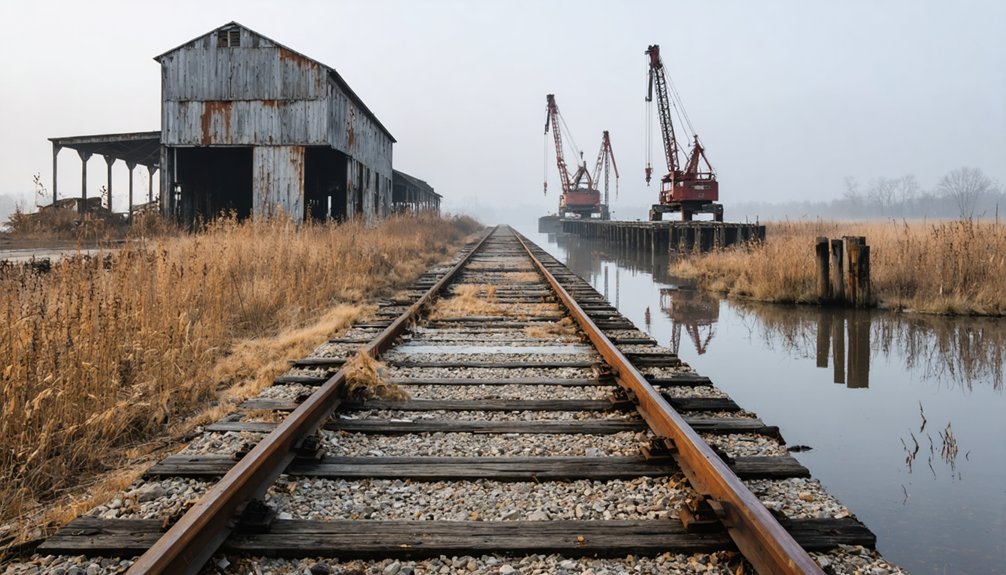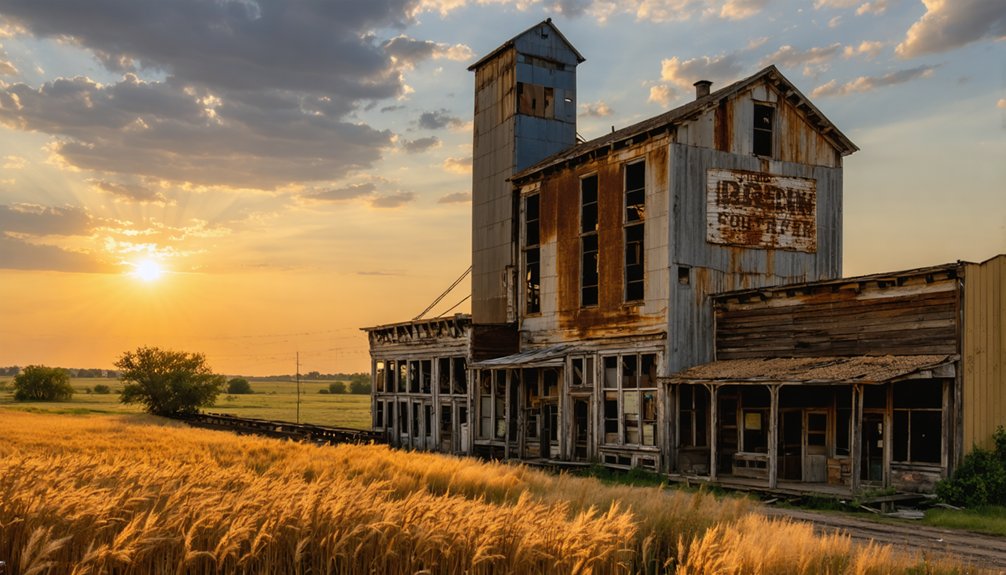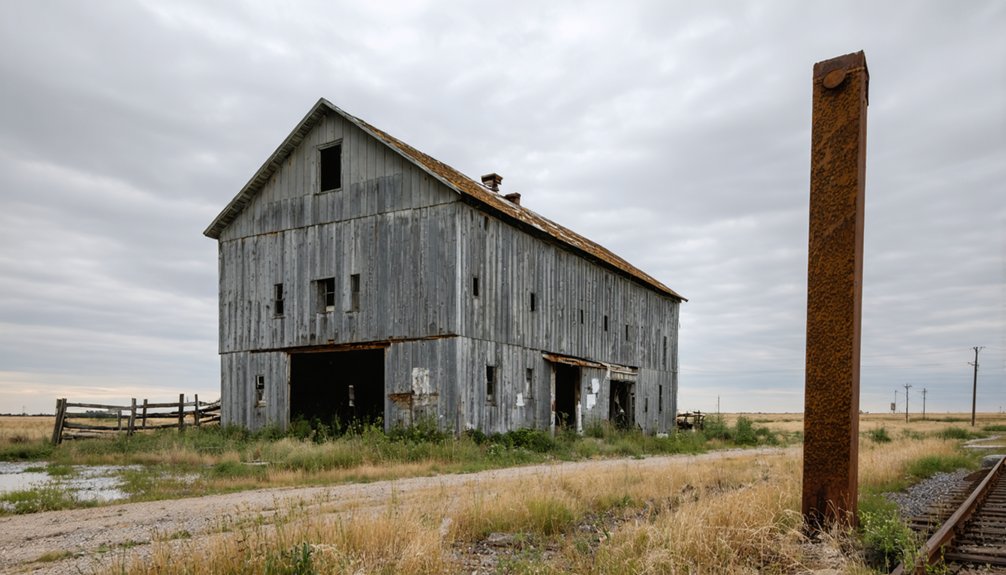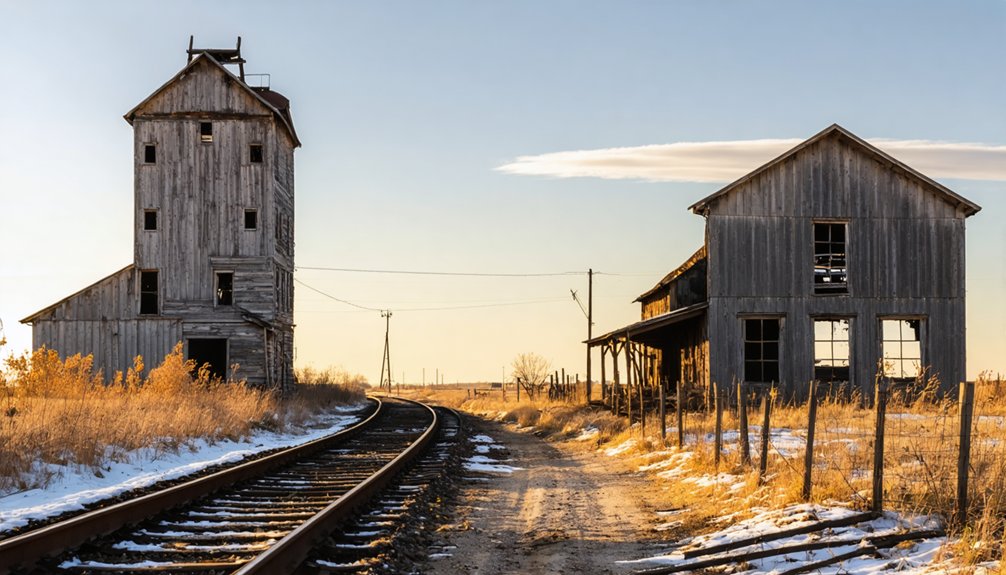You’ll find Ivanhoe’s ghostly remains between sections 29 and 30 of Franklin Township, Iowa, along the historic Dubuque and Iowa City Military Road. This once-promising settlement began in 1839 with Colonel Merritt’s store and thrived as a crucial river crossing point on the Cedar River. Despite founder Anson Cowles’ ambitious plans for a university and wildlife park, the town declined after 1849. The old cemetery and Ivanhoe Bridge preserve fascinating stories of this lost pioneer community.
Key Takeaways
- Ivanhoe was established in 1839 along the Cedar River in Franklin Township, featuring a store, post office, and ferry service.
- The town’s decline began after 1849 when the post office closed and nearby cities Marion and Cedar Rapids drew residents away.
- Lack of official platting, railroad connections, and competition from larger towns contributed to Ivanhoe’s transformation into a ghost town.
- Today, only a historic cemetery with pioneer graves and the Ivanhoe Bridge remain as physical evidence of the former settlement.
- The settlement was named after Sir Walter Scott’s novels and originally had ambitious plans for a university and wildlife park.
The Birth of a River Settlement
Located strategically between sections 29 and 30 of Franklin Township, Ivanhoe quickly attracted settlers thanks to its position on the essential Dubuque and Iowa City Military Road.
Colonel Merritt opened the first store in 1839, and by 1845, you’d have found a functioning post office serving the growing community. Like nearby Mount Vernon, the settlement emerged as an important service point along Military Road.
The area’s natural advantages – fertile soil, timber resources, and river access – made it an attractive destination for those seeking opportunity in Iowa’s frontier lands. Founder Anson Cowles had ambitious plans to establish a university and wildlife park in the settlement.
Pioneer Life Along Cedar River
You’d find pioneer life along Cedar River centered around key crossing points, where solid rock riverbeds allowed safe passage for both people and goods during trading expeditions.
Early settlers established trading relationships at these natural fords, exchanging agricultural products, lumber, and manufactured goods from the water-powered mills that dotted the riverbank. The Sauk and Fox tribes had established thriving communities in this region since the early 1700s before European settlement began. Evidence shows that Native Americans inhabited this area for 9,500 years before pioneers arrived.
The river crossings also served as natural gathering places where pioneer families would meet for social events, church services, and community celebrations that helped ease the isolation of frontier life.
River Crossing Daily Life
Along the Cedar River’s solid rock riverbed, pioneers established thriving communities that centered around an essential natural crossing point located seven miles below the Falls of the Cedar.
You’d find settlers building cabins near this strategic location, where river crossing rituals merged with indigenous navigation patterns that had existed for centuries. The crossing point served as more than just a way to ford the river – it became the heart of pioneer life. Much like the American Indians who traded peacefully with settlers in other parts of Iowa, local tribes shared their knowledge of the river’s best crossing points.
You could see the daily rhythm of settlers farming the fertile prairie, drawing water for drinking and irrigation, while fishermen cast their lines for dinner. The rich soil composition resulted from centuries of glacial drift deposits that created ideal conditions for agriculture.
The river’s power didn’t go to waste, as entrepreneurs harnessed it for sawmills and gristmills. By 1850, you’d find a proper post office, and schools followed shortly after, marking the transformation from wilderness to civilization.
Early Trading Activities
When William H. Merritt opened Ivanhoe’s first store in 1839, he established what would become a crucial trading hub along the Cedar River.
The historical romance novels that were popular at the time influenced the town’s naming after Sir Walter Scott’s famous work. You’d find settler interactions flourishing at this strategic location, where the Military Road crossed the river, creating perfect conditions for commerce. The trading dynamics were complex, involving multiple groups: pioneer settlers, indigenous peoples, and merchants from places like Rock Island. John Wolfe’s ferry became essential to these trading operations.
The government’s Indian trading depot, established that same year, made Ivanhoe a significant point of exchange between cultures.
You could spot flatboats and keelboats maneuvering the Cedar River, carrying wheat and other agricultural products downstream. The American Fur Company‘s presence added another layer to the commercial activity, reflecting the frontier town’s importance in regional trade networks during these early settlement years.
Settler Social Gatherings
Beyond the bustling trade activities, social life in Ivanhoe centered around John Wolfe’s boat-house, which served as both a hotel and a vibrant gathering place for settlers.
You’d find community bonding happening naturally along the Cedar River, where settlers from diverse backgrounds came together, sharing experiences and forging connections.
- Wolfe’s ferry operations created daily opportunities for cultural exchanges between travelers and locals.
- The river provided a natural backdrop for fishing gatherings and water-based social activities.
- Bohemian families brought their unique traditions to the community by the early 1900s.
- Despite the area’s reputation for harboring horse thieves and counterfeiters, settlers maintained strong social bonds.
The waterfront location became the heart of settler interactions, where you’d witness the blending of various cultural influences that shaped Ivanhoe’s unique social fabric.
Early Commerce and Trade
Despite its promising location and initial prospects, Ivanhoe’s commercial ventures began modestly with William H. Merritt opening the first store in spring 1839.
You’ll find that while the settlement was expected to become a major trading center due to its strategic position on the Old Military Road, it struggled to fulfill these expectations. The establishment of a post office in 1845 briefly strengthened the town’s commercial presence, but this service lasted only until 1849.
Even with abundant timber resources and its early status as one of Linn County’s first three communities, Ivanhoe faced mounting challenges. The lack of official platting and growing competition from nearby towns like Marion and Cedar Rapids contributed to its commercial decline, ultimately failing to capitalize on its natural advantages. The emergence of larger discount stores in neighboring communities further weakened Ivanhoe’s struggling local businesses.
Transportation Hub and Ferry Point

At the junction of the Old Military Road and Cedar River, you’ll find Ivanhoe’s strategic location served as an essential transportation nexus for early Iowa pioneers.
The Ivanhoe Ferry, operating from the town’s prime position south of Mount Vernon, provided significant river crossing services that connected regional trails and facilitated commerce between Dubuque and Iowa City. Stagecoach travel frequently depended on ferry crossings like Ivanhoe’s to maintain reliable mail and passenger routes across Iowa’s rivers.
Your understanding of early Iowa transportation would be incomplete without recognizing how Ivanhoe’s ferry point transformed local trade, enabling the movement of settlers, goods, and livestock across the Cedar River before modern bridges existed.
Early River Crossing Operations
During the early pioneer era, Ivanhoe established itself as an essential transportation hub where the Cedar River intersected with the Old Military Road.
River navigation proved challenging, with unpredictable currents and seasonal water levels making crossings treacherous for settlers heading west. The Ivanhoe Ferry became vital for safe passage across the Cedar River before bridge construction began.
- You’ll find historical records showing the ferry’s operation as early as 1838
- You can trace the U.S. government’s strategic placement of the Military Road from Dubuque to Iowa City
- You’ll discover how weather conditions dramatically impacted crossing schedules
- You can explore evidence of early ferry operations that shaped settlement patterns
The lack of official platting ultimately limited Ivanhoe’s growth, but its role in early river crossings remains significant in Iowa’s pioneer history.
Strategic Pioneer Route Location
While many pioneer settlements struggled to establish viable transportation networks, Ivanhoe’s strategic position at the intersection of the Cedar River and the Dubuque-Iowa City Military Road made it a natural transportation hub in Iowa Territory.
You’ll find this pioneer infrastructure connected multiple county seats, linking essential settlements like Dubuque, Cascade, and Iowa City while positioning Ivanhoe as a critical waypoint for travelers.
The location offered compelling economic opportunities, combining river access with established land routes.
You’d have seen stagecoaches, traders, and settlers converging at this junction where the Marion-Mt. Vernon road met the military route.
The site’s significance was further enhanced by its proximity to timber resources and its position along government-mandated territorial routes, making it a promising frontier outpost for early commercial development.
Ferry Trade Impact
The establishment of Ivanhoe Ferry marked a defining chapter in the settlement’s development as a transportation nexus.
You’ll find that ferry commerce thrived at this strategic crossing point, where the Cedar River intersected with the essential Dubuque-Iowa City road. River transportation facilitated the movement of timber, agricultural goods, and pioneers across the waterway.
Here’s what made Ivanhoe’s ferry trade significant:
- William H. Merritt’s store and other businesses emerged to serve travelers
- The ferry enabled critical freight transport throughout Franklin Township
- Good river frontage attracted merchants and enhanced market connections
- The location supported both water and overland route connections
Though promising, Ivanhoe’s ferry-based economy ultimately faced challenges from seasonal river conditions and emerging railroad competition, leading to its eventual decline.
The Brief Golden Age

As pioneers settled along the Cedar River in 1838, Ivanhoe emerged as a promising frontier outpost that enjoyed several advantages over its neighboring settlements.
You’d have found golden opportunities at every turn: prime riverfront access, rich agricultural land, abundant timber, and a strategic position along the Old Military Road connecting Dubuque to Iowa City.
During its fleeting prosperity between 1838 and 1849, you could’ve traded at Colonel Merritt’s store or used the local post office while surrounded by the natural beauty of the Cedar River valley.
The settlement’s position at this essential crossroads made it seem destined for greatness, with local histories noting that Ivanhoe held better prospects than any other town in the county.
Yet this golden age would prove remarkably brief, despite the settlement’s apparent advantages.
Decline and Exodus
Despite Ivanhoe’s promising location and natural advantages, nearby towns Marion and Cedar Rapids soon eclipsed the settlement’s prospects, triggering a gradual exodus of residents and businesses.
The population shifts reflected deeper issues beyond mere competition. A lack of community cohesion, formal planning, and civic investment left Ivanhoe vulnerable.
You’ll find that four key factors sealed the town’s fate:
- The absence of a railroad connection isolated the settlement from regional commerce.
- No official platting meant the town remained in “squatter” status without municipal structure.
- The closure of the post office in 1849 marked the end of formal civic functions.
- A reputation for attracting unsavory elements deterred families and legitimate businesses.
Traces Left Behind

Modern visitors to Ivanhoe’s former site will find sparse physical evidence of this once-promising settlement, with only the historic cemetery and an active quarry bearing the town’s name still marking its existence.
You’ll find the Ivanhoe Bridge spanning the Cedar River, though many cross it without knowing its historical significance.
While physical historical artifacts may be scarce, community stories and documented records keep Ivanhoe’s memory alive.
The February 1921 edition of “The Palimpsest” preserves tales of the area’s more colorful history, including its reputation as a haven for horse thieves and counterfeiters.
You can still trace the path of the Old Military Road that once brought travelers through this frontier town, though the ferry that carried them across the Cedar River is long gone.
Legacy in Local Memory
The legacy of Ivanhoe lives on through local place names and landmarks that dot the landscape of Linn County.
You’ll find its memory preserved in Ivanhoe Road near Ely and the historic ferry crossing point on Highway 1. The community remembrance centers on the Ivanhoe Cemetery, where pioneer graves tell stories of early settlers who shaped this land.
- Visit the Ivanhoe Cemetery to explore the only tangible remnant of this ghost town
- Drive along Ivanhoe Road to trace the path of the old ferry crossing
- Research your family connections through local genealogical records
- Explore historical narratives in Linn County’s archives and memoirs
These fragments of history weave together to form a rich tapestry of Iowa’s pioneering heritage, reminding you of the transient nature of early settlements and their lasting impact on modern infrastructure.
Lessons From a Lost Town

Learning from Ivanhoe’s dissolution reveals vital insights about frontier settlement sustainability.
You’ll notice that without formal planning and legal status, even promising locations can fade into obscurity. The town’s failure to adapt as transportation networks evolved beyond river routes and primitive trails proved fatal, while its lack of civic institutions and social cohesion undermined community resilience.
Economic adaptation was essential – Ivanhoe couldn’t shift from a frontier outpost when nearby towns modernized. While natural resources and scenic beauty attracted initial settlers, you need infrastructure investment and trustworthy commerce to sustain growth.
The lessons are clear: successful towns require formal organization, diverse economic foundations, strong social bonds, and the ability to evolve with changing regional dynamics.
Frequently Asked Questions
Were There Any Notable Crimes or Murders Reported in Ivanhoe?
You won’t find any documented crimes or mysterious disappearances in historical records, and there aren’t even local legends about criminal activity during Ivanhoe’s brief existence as a settlement.
What Native American Tribes Originally Inhabited the Ivanhoe Area?
You’ll find that the Sauk and Meskwaki (Fox) tribes were the primary Native peoples who called this region home, enriching the cultural heritage of eastern Iowa before European settlement.
How Much Did It Cost to Use Ivanhoe’s Ferry Service?
You won’t find exact ferry rates for Ivanhoe’s service, as historical records don’t document specific costs. While ferries held great historical significance in Iowa’s river towns, actual pricing details remain unknown.
Did Any Famous Pioneers or Historical Figures Pass Through Ivanhoe?
While thousands of pioneers traveled through the region, you won’t find records of famous historical figures visiting Ivanhoe. Local entrepreneurs and traders made up most pioneer journeys through this brief settlement.
What Happened to the Original Documents and Records From Ivanhoe’s Post Office?
You won’t find most original postal history records since they’re likely lost to time, though some might exist in National Archives microfilm collections or scattered state repositories awaiting document preservation efforts.
References
- https://dungherder.wordpress.com/2018/03/09/abandoned-iowa-ivanhoe/
- https://www.elyhistory.com/2021/01/about-ivanhoe-and-wolfe-family.html
- https://kids.kiddle.co/List_of_ghost_towns_in_Iowa
- https://www.youtube.com/watch?v=1J0Qx64ZrwI
- https://www.gutenberg.org/files/42220/42220-h/42220-h.htm
- https://pubs.lib.uiowa.edu/annals-of-iowa/article/7045/galley/115796/view/
- https://en.wikipedia.org/wiki/List_of_ghost_towns_in_Iowa
- https://mvhpc.org/a-short-history-of-mount-vernon/
- https://mvhpc.org/the-virgil-crofter-collection/
- https://ouriowaheritage.com/fales-to-mason-1850/



